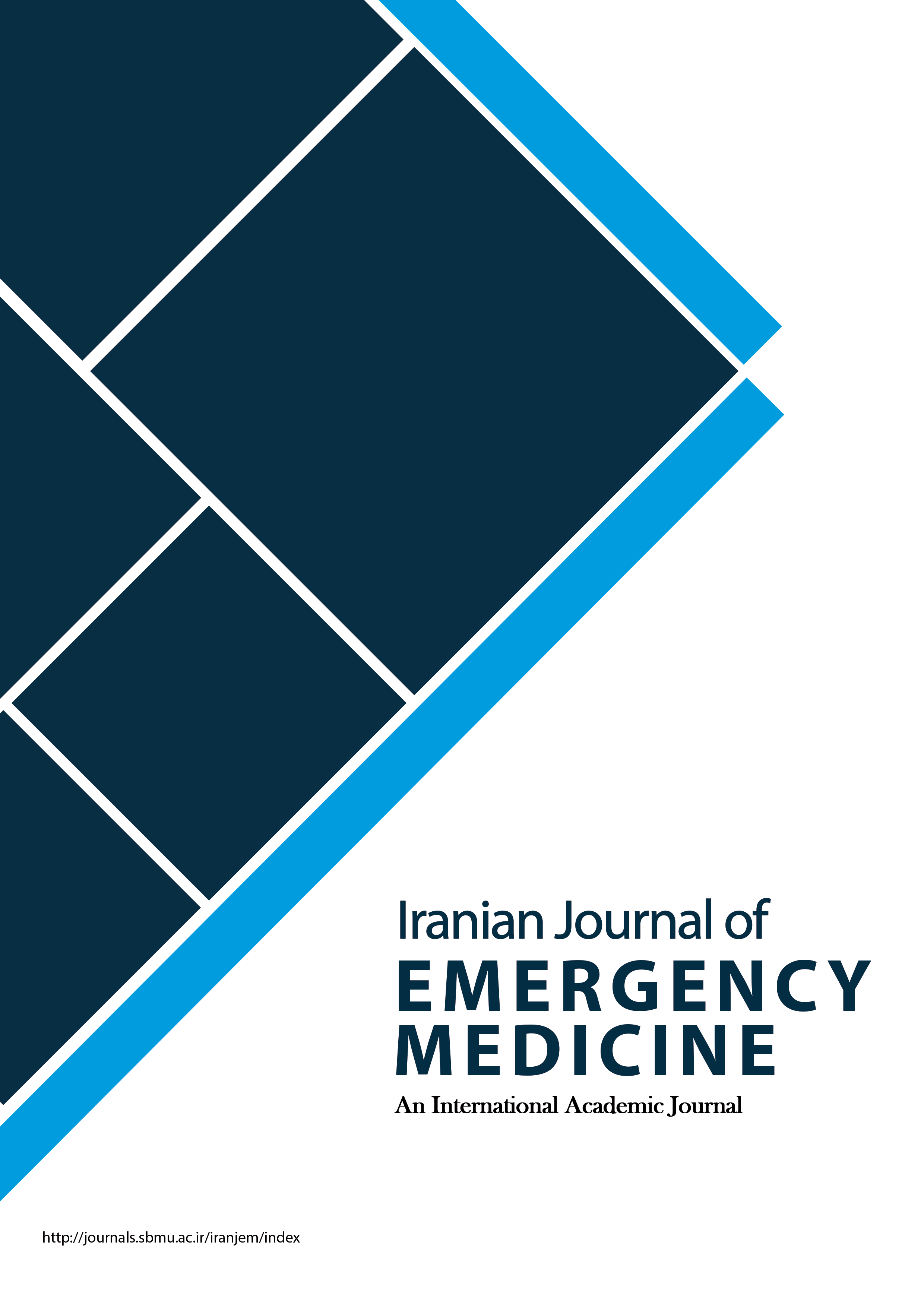Airway Management via Insertion of Laryngeal Tube versus Combitube into a Manikin by Emergency Medicine Residents
Iranian Journal of Emergency Medicine,
Vol. 4 No. 4 (2017),
8 October 2017
,
Page 179-174
https://doi.org/10.22037/ijem.v2i1.17634
Abstract
Introduction: Laryngeal tube (LT) and combitube (CT) are among devices used for establishing the airway in patients. This study was done with the purpose of comparing the success rate and duration of intubation when emergency medicine (EM) residents used LT or CT. Methods: In this cross sectional study, carried out in Tabriz, Iran, in 2016, all EM residents of Tabriz University of Medical Sciences were included. Number of attempts and time required for successful intubation via LT and CT and airway management were evaluated for each participant using a manikin. Results: A total of 52 EM residents in three groups (First Year: 17, Second Year: 16, and Third Year: 19) with the mean age of 36.24 ± 9.21 years participated in this study (61.53% male). All the residents were successful in inserting LT and CT on the first attempt. Mean duration of CT and LT placement in third year residents (7.5 ± 2.01, 6.39 ± 1.21, respectively) was significantly shorter than second year residents (9.25 ± 2.87, 8.06 ± 2.24, respectively) and first year residents (13.06 ± 3.54, 11.76 ± 2.43, respectively). Mean duration of CT placement (9.9 ± 3.15) was significantly greater than LT placement (8.71 ± 2.88) (p<0.05). Conclusion: Based on the results obtained in the present study, EM residents were successful in LT and CT placement into a manikin on the first attempt. However, time required for placement of LT was shorter than CT.- مدیریت راه هوایی؛ لوله گذاری؛ طب اورژانس؛ مولاژ آموزشی
How to Cite
References
Thierbach A, Piepho T, Maybauer M. The EasyTube for airway management in emergencies. Prehospital emergency care: official journal of the National Association of EMS Physicians and the National Association of State EMS Directors. 2004;9(4):445-8.
Agro F, Frass M, Benumof J, Krafft P. Current status of the Combitube: a review of the literature. Journal of clinical anesthesia. 2002;14(4):307-14.
Garner A, Rashford S, Lee A, Bartolacci R. Addition of physicians to paramedic helicopter services decreases blunt trauma mortality. The Australian and New Zealand journal of surgery. 1999;69(10):697-701.
Sanson G, Di Bartolomeo S, Nardi G, Albanese P, Diani A, Raffin L, et al. Road traffic accidents with vehicular entrapment: incidence of major injuries and need for advanced life support. European journal of emergency medicine: official journal of the European Society for Emergency Medicine. 1999;6(4):285-91.
Deakin C, Peters R, Tomlinson P, Cassidy M. Securing the prehospital airway: a comparison of laryngeal mask insertion and endotracheal intubation by UK paramedics. Emergency medicine journal: EMJ. 2005;22(1):64-7.
Saeedi M, Hajiseyedjavadi H, Seyedhosseini J, Eslami V, Sheikhmotaharvahedi H. Comparison of endotracheal intubation, combitube, and laryngeal mask airway between inexperienced and experienced emergency medical staff: A manikin study. International journal of critical illness and injury science. 2014;4(4):303-8.
Brimacombe J, Keller C, Brimacombe L. A comparison of the laryngeal mask airway ProSeal and the laryngeal tube airway in paralyzed anesthetized adult patients undergoing pressure-
controlled ventilation. Anesthesia and analgesia. 2002;95(3):770-6, table of contents.
Cattano D, Ferrario L, Patel CB, Normand KC, Seitan C, Hagberg CA. Laryngeal Tube Suction-D, Combitube, and Proseal Laryngeal Mask Airway: Randomized Clinical Trial. Journal of Anesthesiology and Clinical Research. 2012;1(1):8.
Wang H, Lave J, Sirio C, Yealy D. Paramedic intubation errors: isolated events or symptoms of larger problems? Health affairs (Project Hope). 2006;25(2):501-9.
Bein B, Carstensen S, Gleim M, Claus L, Tonner P, Steinfath M, et al. A comparison of the proseal laryngeal mask airway, the laryngeal tube S and the oesophageal-tracheal combitube during routine surgical procedures. European journal of anaesthesiology. 2005;22(5):341-6.
Cook T, McCormick B, Asai T. Randomized comparison of laryngeal tube with classic laryngeal mask airway for anaesthesia with controlled ventilation. British journal of anaesthesia. 2003;91(3):373-8.
Pennant J, Pace N, Gajraj N. Role of the laryngeal mask airway in the immobile cervical spine. Journal of clinical anesthesia. 1993;5(3):226-30.
Asai T, Wagle A, Stacey M. Placement of the intubating laryngeal mask is easier than the laryngeal mask during manual in-line neck stabilization. British journal of anaesthesia. 1999;82(5):712-4.
Voscopoulos C, Barker T, Listwa T, Nelson S, Pozner C, Liu X, et al. A comparison of the speed, success rate, and retention of rescue airway devices placed by first-responder emergency medical technicians: a high-fidelity human patient simulation study. The Journal of emergency medicine. 2013;44(4):784-9.
- Abstract Viewed: 808 times
- PDF (فارسی) Downloaded: 760 times
- HTML (فارسی) Downloaded: 206 times



